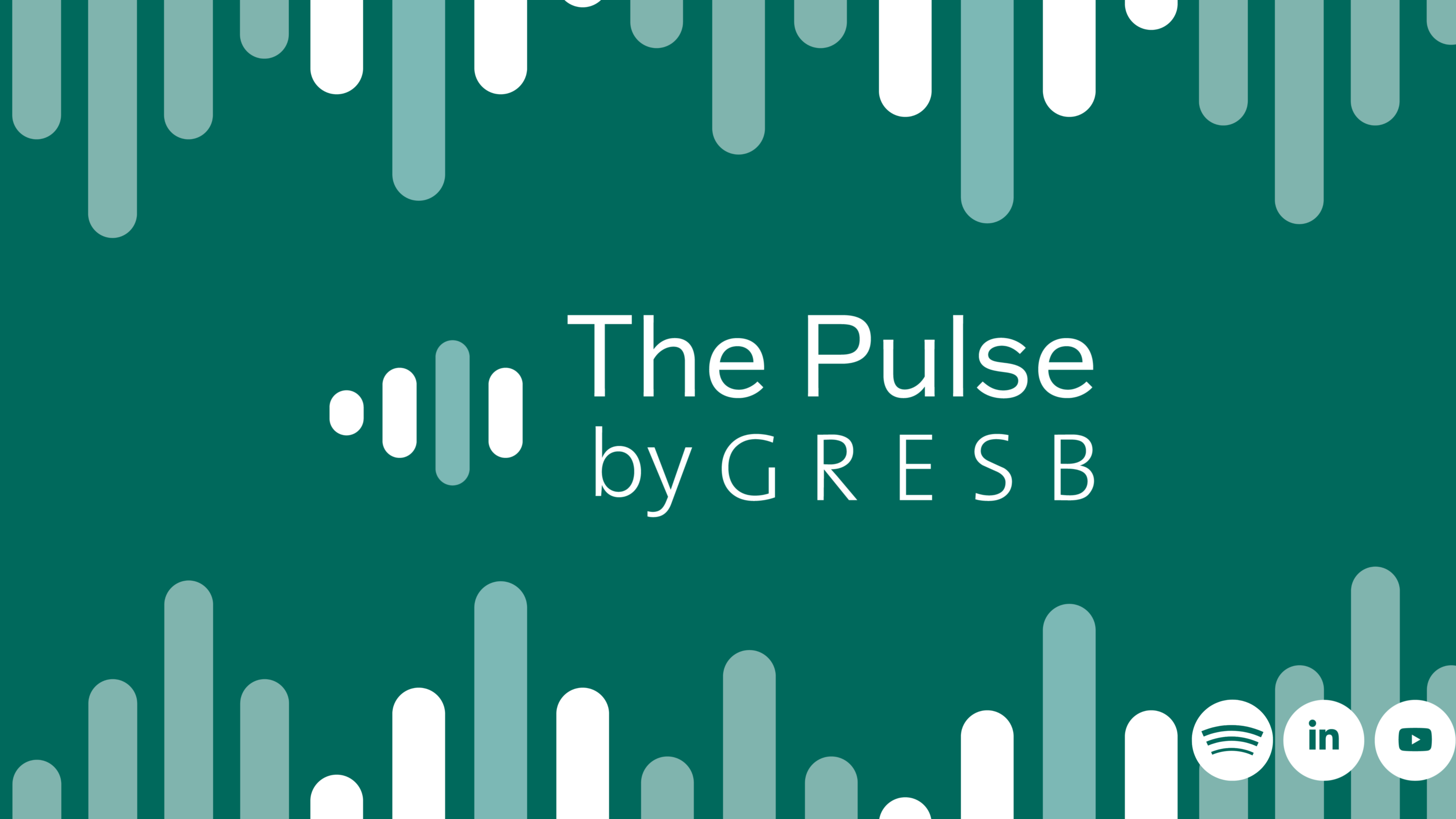
Introducing The Pulse by GRESB
The Pulse by GRESB is an insightful content series featuring the GRESB team, partners, GRESB Foundation members, and other experts. Each episode focuses on an important topic related to either GRESB, ESG issues within real assets industry, decarbonization efforts, or the wider market.
- Watch on Youtube
- Listen on Spotify
- Listen on Apple Podcasts
REAL talk: A deep dive into REAL Benchmarks
For this episode of The Pulse by GRESB, we are bringing you a conversation about REAL Benchmarks, GRESB’s new private dashboard for real estate managers and companies to delve into the energy and GHG emissions data of all assets within their portfolio, allowing for detailed analysis of how each asset contributes to the portfolio’s overall performance.
Watch the episode below, featuring:
Transcript
Can’t listen? Read the full transcript below. Please note that edits have been made for readability.
Parag Cameron-Rastogi: Welcome to The Pulse by GRESB, our new interview series where we discuss the newest and most topical issues in sustainable real assets, from GRESB and ESG to the wider industry. Today, I’m your host, Parag Cameron-Rastogi. I’m Director of Innovation with GRESB, and I’m going to be speaking today with Christina, who is the Product Manager for REAL Solutions.
Christina Djambazca: Hi, Parag. Thank you so much for having me today.
Parag Cameron-Rastogi: Good to have you here, Christina. Let’s dive straight into it. What is REAL?
Christina Djambazca: Well, REAL Benchmarks is the first product out of the REAL suite of solutions that GRESB is going to be launching over the next couple of years. With REAL Benchmarks, Real Estate [GRESB] Participants are going to be able to get deep and actionable insights into the energy and GHG performance of their portfolios.
This tool is going to be powered straight with data from the GRESB Asset Portal, which means that it does not rely on the annual GRESB submission cycle, and it’s going to allow Participants to understand their performance when it comes to energy and GHG, be able to fill that in with estimations when 100 percent data coverage for their assets is not available, also be able to benchmark their performance against the GRESB asset data set, as well as the CRREM Pathways, and be able to see and understand how exactly their individual assets within their portfolios perform.
Parag Cameron-Rastogi: That sounds like a really cool deal, but before, and I’m really keen to jump into the data that powers the dashboard. I have so many questions about that. But before we do that, can you talk a little bit about how all this functionality is actually brought to a user and who’s the user you have in mind when you built this?
Christina Djambazca: Yes, of course. So, the user in this case would be the GRESB Real Estate Participants only. So, this would be the fund managers that complete the annual GRESB [Real Estate] Assessment. We are starting with allowing Participants to understand their portfolio, but the ultimate goal behind all of this is to help them answer the questions that they receive from their own investors on: how do individual assets within their portfolios perform?
Parag Cameron-Rastogi: That’s really cool. You know, I could only wait this long to start talking about the database. So, let’s get into that. You know, I’ve been looking at the database myself a little bit. It has this amazing geographic and sectoral coverage. I mean, I found that, for example, lots of large global cities are well represented (e.g., London, Toronto, Tokyo, Singapore, New York City).
But the database is actually fairly broad. We have 170 cities across 24 countries, which have 50 or more assets just in 2022 alone. There is also about 25 percent offices, industrial is [about] 16 percent, residential [is] about 23 percent, and retail [is] about 12 percent, forming the largest sectoral divisions within the database. Could you talk a little bit about how this database was actually built up and what connection it has to the annual [GRESB] Assessment?
Christina Djambazca: Yes, of course. GRESB has been mandating asset-level reporting as part of the GRESB Real Estate Assessment since 2020, which means that we now have three, soon-to-be-four years of asset-level data reporting for over 2000 funds in 2023. Of course, the demand for participation in the Real Estate Assessment is the main driver behind the size of our dataset, and this is what is allowing us to build granular asset-level benchmarks for the wide geographies that you mentioned, but also many more countries and property types globally.
Parag Cameron-Rastogi: That’s fascinating. So, this is empirically constructing benchmarks based on geographic location as well as sector. This means, of course, that we’re using real data, which is the real power of this database. If I’m submitting data to GRESB and it’s being used to construct this benchmark, how can you assure confidentiality and that my data is still private?
Christina Djambazca: That’s a great question. So, the REAL Benchmarks dashboard is, first of all, going to be available to Real Estate Participants only. So, they will be the only ones that can control access to the dashboard, and they will be the only ones that will be able to see insights. So, when it comes to a Participant’s own individual asset-level data and insights, they will be the only ones who are able to see this and then choose whether they want to share that with investors.
When it comes to the benchmarking insights that support the dashboard, those are constructed in an empirical way following a standard methodology. The first step out of that methodology is to strip the individual assets of any identifiers. So, there is no mention of the asset’s location. There is no mention of the owner of the buildings or the portfolio under which they have been reported. After this, the process ensures that a minimum count of 20 assets within a property subtype and country can be identified, which further assures anonymity. So, the insights themselves, the only thing that they represent is: how does the building stock that has been reported to GRESB in a specific country and in a specific property subtype perform? But that is stripped out of any identifiers of where exactly the data comes from. So, Participants can be assured that their data is being kept secure.
Parag Cameron-Rastogi: That’s, of course, a great message to send out there to all potential users and people who submit data to the Real Estate Assessment because everything is done in confidential systems. What we’re trying to do with this — and I’d love for you to speak a little bit more about this — we’re taking the data that Participants submit to us, and we give them this wonderful benchmark, the GRESB rating, which is a very useful yardstick against which to measure your performance. But with REAL Solutions, it seems that, for the first time, we’re now opening up into a continuous feedback mechanism at the asset level, which perhaps wasn’t available to Participants before.
Christina Djambazca: Yes. That is indeed correct. And that all stems from a transformative shift within the industry that we have been observing over the last couple of years. So, GRESB’s position within the market has always been to equip real estate fund managers to answer investors’ questions when it comes to ESG performance. Those questions, for a very long time, revolved around fund-level performance. So, how does the fund perform? What are the practices, risk assessments, [and] policies that monitor or govern sound ESG performance within the fund? Then, the questions evolved to: can you monitor performance? Do you understand performance? Do you have the data? We all know how much Participants struggle with obtaining data coverage for their assets. Now, in the last couple of years, those questions have shifted to: what is your actual performance and how can you demonstrate that you’re improving that at the level at which it matters (which tends to be the asset level)?
So through the REAL suite of solutions, what GRESB is trying to do is equip Participants with the right tools to answer the questions that investors are now asking.
Parag Cameron-Rastogi: That would be really interesting, of course. And, you know, since this feels a little bit abstract and this is an audio recording, so we aren’t actually showing the dashboard, maybe let’s take a minute to talk about, so [if] I’m a Participant, [if] I’m a fund manager and [if] I have a dozen assets. [If] I’m in, maybe, multiple cities, in multiple countries. How would I go about using this benchmark, and what kind of key metrics am I expecting to get out of it?
Christina Djambazca: So, through the REAL Benchmarks dashboard, what Participants would be able to do is answer questions around the question: what are the assets within my portfolio that are lagging in terms of performance? So, how do they compare against the local building stock? Which ones are the ones that I have to invest in more, or do I have to fix first, and I have to put a lot more effort in as soon as possible? Another use case for the same information would be, well, basically the opposite. Which are my best-performing assets? And how can I make sure that I position them favorably in front of my investors, in front of internal stakeholders, [to] be able to showcase best performance against the GRESB Real Estate benchmark? So, the demonstration of performance really is the first step in understanding what exactly and where exactly improvements can be made further along.
Parag Cameron-Rastogi: Yes, I think this makes me think about some feedback that I myself have received from the industry, from Participants and investors, about how the GRESB Benchmark is actually globally consistent and comparable, which is a really useful thing for the industry to have because when you’re talking about decarbonization, we all live on the same planet. So, we better benchmark our buildings in a comparable way across the world. Let’s end with a quick question about where you see the future of this benchmark, the REAL Benchmarks product?
Christina Djambazca: We were lucky enough to benefit from a lot of industry engagement during the development of REAL Benchmarks. That gave us a lot of insight into the challenges that our Participants are facing when it comes to asset-level data. One of the main pieces of feedback we heard over and over again was that the GRESB Score is a very powerful tool for communicating ESG performance with external stakeholders.
What they struggle to be able to do is translate the GRESB Score into asset-level actionable metrics and understand which exactly are the assets in their portfolio that they need to focus on to be able to improve on that [GRESB] Score. So, as part of the second version of REAL Benchmarks, which is going to be launched in Q4 2024, this is exactly the solution that we want to provide to the market — understand how each individual asset within your portfolio contributes to your overall GRESB Score.
Parag Cameron-Rastogi: Well, I’d love to keep talking, but that’s about all the time for today’s episode of The Pulse by GRESB. Thank you, Christina, for taking the time to join me and sharing your thoughts today.
Christina Djambazca: Thank you so much for having me, Parag. That was great.
Parag Cameron-Rastogi: Well, if you’ve enjoyed the show, don’t forget to give this content a like, share, and leave your comment. We’re constantly developing new episodes, and if you have suggestions for what you’d like us to cover, please get in touch. You can always reach out to us at [email protected]. I’ve been your host, Parag Cameron-Rastogi. See you next time on The Pulse by GRESB. Thank you.

